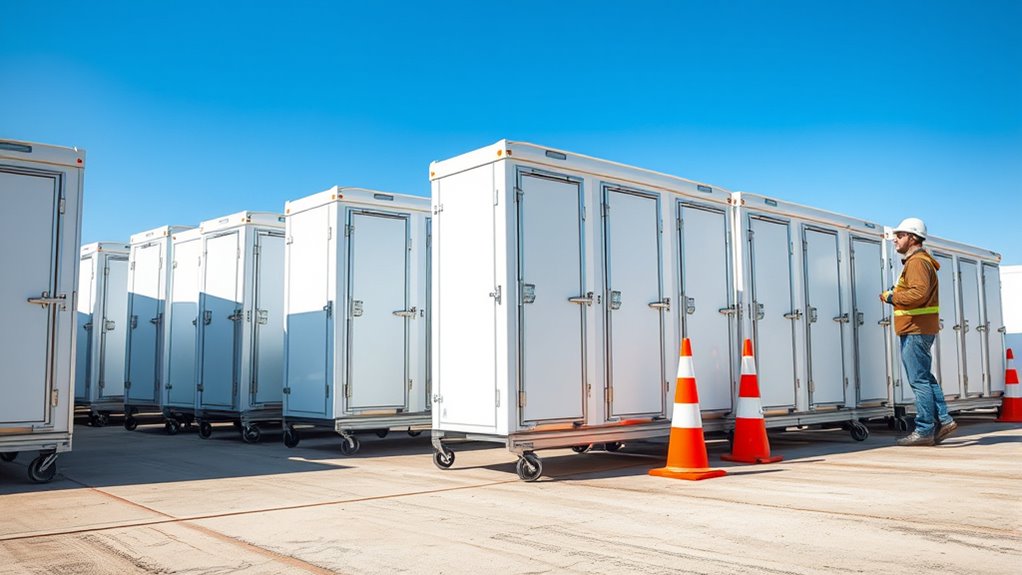To protect your high-value portable restroom assets, you need thorough insurance that covers liability, physical damage, and operational risks. Ensure your policy includes liability coverage for legal and injury claims, property coverage for damages or theft, and equipment breakdown protection. Regularly review and update your policies as your fleet grows or risks change. Staying proactive with your insurance will help keep your business secure and thriving—keep exploring to learn more about securing your assets effectively.
Key Takeaways
- Obtain comprehensive liability coverage to protect against legal claims from injuries or property damage.
- Insure high-value units against theft, vandalism, fire, and natural disasters to ensure quick recovery.
- Include property and equipment breakdown insurance to cover physical damages and operational disruptions.
- Regularly review and update policies to match fleet size, market expansion, and evolving risks.
- Adopt best practices like proactive coverage management to maintain adequate protection and business continuity.

When you invest in high-ticket portable restroom assets, safeguarding that investment becomes essential. These assets often represent significant financial commitments, and without proper insurance, you leave yourself vulnerable to costly risks. Liability coverage is a critical component of protecting your business; it shields you from legal claims that could arise if someone is injured on your portable restrooms or if your units cause property damage. For example, if a guest slips and falls inside or outside a unit, liability coverage can help cover medical expenses, legal fees, and settlement costs, preventing these incidents from draining your resources. Without it, you’d be personally responsible for these damages, which could threaten your financial stability.
Protect your portable restroom investment with liability coverage to prevent costly legal and property damage expenses.
In addition to liability coverage, asset protection plays a crucial role in your overall insurance strategy. Your high-value portable restroom assets are not only expensive but also essential to your operations. Proper insurance ensures these units are protected against theft, vandalism, fire, or natural disasters. Asset protection means you can quickly recover from a loss without suffering a severe financial blow. It also helps to maintain your reputation and operational continuity, as you won’t have to worry about funding the replacement or repair of damaged or stolen units out of pocket. When you have comprehensive coverage, you can focus on growing your business, confident that your assets are shielded from unexpected setbacks. Furthermore, understanding your local store hours can assist you in managing equipment maintenance and repairs efficiently.
Another key aspect is understanding the types of coverage that best suit your needs. Beyond liability and property coverage, consider options like equipment breakdown or business interruption insurance. These can provide extra layers of security, ensuring that even in unforeseen circumstances, your cash flow remains stable and your units stay protected. It’s also important to review your policy regularly and update it as your fleet grows or your business expands into new markets. This proactive approach ensures you’re not underinsured and that your coverage aligns with your current asset values and operational risks.
Ultimately, protecting your high-ticket portable restroom assets requires a strategic approach to insurance. Liability coverage minimizes your exposure to legal claims, while asset protection ensures your investments are safe from physical threats. Together, these elements form a robust safety net that allows you to operate confidently and grow your business without constant worry about what might go wrong. Investing in the right insurance isn’t just a legal requirement; it’s a smart move to preserve your assets and secure your future in the portable restroom industry.
Frequently Asked Questions
How Do I Determine the Appropriate Coverage Limits for My Assets?
To determine the appropriate coverage limits, start by evaluating your assets’ value through asset valuation. Consider the replacement cost and market value of your portable restrooms. Use this information for your coverage calculation, ensuring it’s sufficient to repair or replace assets if damaged or lost. Regularly review your valuations and adjust coverage limits accordingly, so you’re always protected without overpaying for unnecessary coverage.
Are There Specific Insurance Policies Tailored for Portable Restroom Assets?
You should explore specialized coverage options designed specifically for portable restroom assets. These policies focus on asset protection, ensuring your high-ticket equipment is well-covered against risks like theft, damage, or accidents. By choosing tailored insurance, you get peace of mind knowing that your assets are protected with coverage that matches their value and unique needs. Always consult an expert to find the best policies that offer extensive specialized coverage for your portable restrooms.
What Types of Risks Are Typically Excluded From Standard Insurance Policies?
Imagine your portable restrooms face an invisible wall—standard policies often exclude major risks like liability exclusions and coverage gaps. These policies typically don’t cover natural disasters, intentional damage, or theft, leaving you vulnerable. You might think you’re protected, but these exclusions can cause huge financial headaches. Always scrutinize your policy to identify liability exclusions and coverage gaps, so you’re not caught off guard when the unexpected strikes.
How Can I Reduce Insurance Premiums for High-Ticket Restroom Assets?
To reduce insurance premiums for your high-ticket restroom assets, focus on proactive measures. Conduct regular risk assessments to identify potential hazards early, and perform preventive maintenance to keep everything in top shape. Insurers favor businesses that minimize risks through these practices, often leading to lower premiums. By demonstrating your commitment to safety and upkeep, you can negotiate better rates and protect your valuable assets effectively.
What Documentation Is Required to File an Insurance Claim for Damages?
Preparing for a claim? You need clear claim documentation and a thorough damage assessment. Collect photographs of the damage, detailed incident reports, and proof of ownership or maintenance records. Make sure your documentation is detailed and accurate. This helps your insurer understand the situation swiftly and smoothly. By providing extensive claim documentation paired with a precise damage assessment, you speed up your settlement process and secure the support you need for your high-ticket restroom assets.
Conclusion
Protecting your high-ticket portable restrooms is like anchoring a ship in a storm—you need steady insurance coverage to weather any surprises. By understanding the essentials, you make sure your assets stay safe and your business sails smoothly. Don’t leave your investment to chance; instead, build a fortress of coverage around your assets. With the right insurance, you’ll navigate the challenges of the industry with confidence, keeping your fleet secure and your peace of mind intact.









